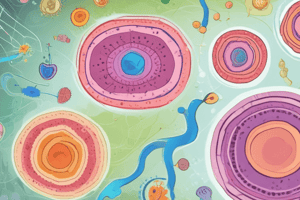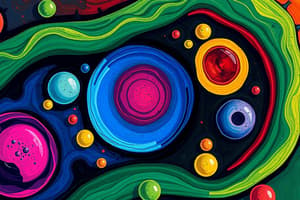Podcast
Questions and Answers
What is the primary function of the nucleolus within the nucleus?
What is the primary function of the nucleolus within the nucleus?
- Modification of ribosomal RNA
- Storage of DNA
- Assembly of ribosomes (correct)
- Synthesis of ribosomal DNA
What distinguishes rough endoplasmic reticulum (RER) from smooth endoplasmic reticulum (SER)?
What distinguishes rough endoplasmic reticulum (RER) from smooth endoplasmic reticulum (SER)?
- RER has ribosomes attached while SER does not (correct)
- RER is involved in digestion while SER is for detoxification
- RER stores calcium ions while SER transports glucose
- RER synthesizes lipids while SER synthesizes proteins
Which of the following structures produces ATP through aerobic respiration?
Which of the following structures produces ATP through aerobic respiration?
- Nucleus
- Lysosomes
- Golgi apparatus
- Mitochondria (correct)
What is one of the roles of lysosomes within a cell?
What is one of the roles of lysosomes within a cell?
What component of the cytoskeleton is primarily involved in the positioning of organelles?
What component of the cytoskeleton is primarily involved in the positioning of organelles?
How do peroxisomes contribute to cellular function?
How do peroxisomes contribute to cellular function?
Which part of the cell controls the entry and exit of substances?
Which part of the cell controls the entry and exit of substances?
What forms when chromatin condenses during cell replication?
What forms when chromatin condenses during cell replication?
Flashcards
What is the nucleus?
What is the nucleus?
The control center of the cell, containing DNA in the form of chromatin or chromosomes, within a double membrane called the nuclear envelope.
What is the nucleolus?
What is the nucleolus?
The site of ribosome synthesis, found within the nucleus. It forms when parts of chromosomes coding for rRNA bind together during interphase.
What are mitochondria?
What are mitochondria?
The powerhouse of the cell, responsible for producing ATP through aerobic respiration. They contain their own DNA and can reproduce independently.
What is the endoplasmic reticulum?
What is the endoplasmic reticulum?
Signup and view all the flashcards
What is the Golgi apparatus?
What is the Golgi apparatus?
Signup and view all the flashcards
What are lysosomes?
What are lysosomes?
Signup and view all the flashcards
What are peroxisomes?
What are peroxisomes?
Signup and view all the flashcards
What is the cytosol?
What is the cytosol?
Signup and view all the flashcards
Study Notes
Cell Structure and Function
- Nucleus: Enclosed by a double-membrane nuclear envelope with pores for mRNA passage. Contains chromatin (DNA bound to histones) which condenses into chromosomes during cell division. Includes nucleolus, containing ribosomal DNA (rRNA).
Organelles
-
Nucleolus: Site of rRNA transcription from rDNA, where rRNA joins proteins to form ribosomes.
-
Mitochondria: Produce ATP through aerobic respiration. Have double membranes (with cristae projections). Own DNA and ribosomes (70S) and reproduce via division. Mitochondrial matrix is space within the inner membrane.
-
Endoplasmic Reticulum (ER): Consists of smooth (SER) and rough (RER). RER has bound ribosomes and is key to protein synthesis. SER stores calcium ions, facilitates glucose mobilization (removes phosphate from glucose-6-phosphate) and synthesizes lipids and steroid hormones.
-
Golgi apparatus: Modifies and packages products of the ER for secretion or transport within the cell. Composed of membrane-bound sacs.
-
Lysosomes: Small, irregular organelles with hydrolytic enzymes for digestion. Breaks down food particles, unwanted material, and recycles components.
-
Peroxisomes: Small vesicles that inactivate toxic molecules using hydrogen peroxide.
-
Ribosomes: Sites of protein synthesis. Some bound to RER, others free-floating in the cytosol, which is the fluid containing cell molecules.
Cytoskeleton
-
Cytoskeleton: Provides cell shape, strength, and facilitates movement of molecules and organelles. Composed of:
-
Microtubules: Hollow tubes of tubulin. Important in organelle positioning, cilia/flagella movement, cell division (chromosome segregation), and other cellular component movements.
-
Intermediate filaments: Provide structural stability to the cell. Not involved in movement.
-
Microfilaments (actin filaments): Thinnest filaments enabling cell movement, shape change, cytokinesis, organelle transport, and muscle contraction.
-
-
Motor proteins: Use ATP energy to move molecules and organelles along cytoskeletal fibers.
-
Cytosol: The fluid component of the cell that contains the cell's molecules and organelles. It is dynamic, enabling movement of constituents within the cell.
-
Plasma Membrane: Phospholipid bilayer enclosing the cell, regulating substance passage. Contains glycoproteins and glycolipids.
Studying That Suits You
Use AI to generate personalized quizzes and flashcards to suit your learning preferences.




